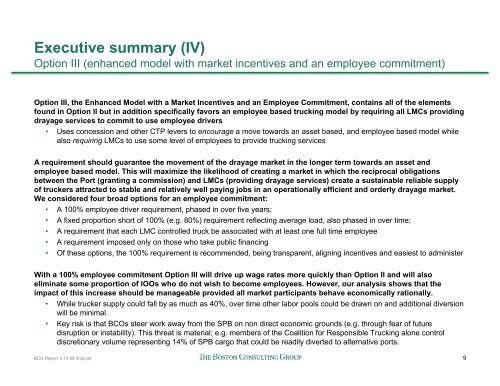BCG Clean Truck Program Analysis - The Port of Los Angeles
BCG Clean Truck Program Analysis - The Port of Los Angeles
BCG Clean Truck Program Analysis - The Port of Los Angeles
Create successful ePaper yourself
Turn your PDF publications into a flip-book with our unique Google optimized e-Paper software.
Executive summary (IV)<br />
Option III (enhanced model with market incentives and an employee commitment)<br />
Option III, the Enhanced Model with a Market Incentives and an Employee Commitment, contains all <strong>of</strong> the elements<br />
found in Option II but in addition specifically favors an employee based trucking model by requiring all LMCs providing<br />
drayage services to commit to use employee drivers<br />
• Uses concession and other CTP levers to encourage a move towards an asset based, and employee based model while<br />
also requiring LMCs to use some level <strong>of</strong> employees to provide trucking services<br />
A requirement should guarantee the movement <strong>of</strong> the drayage market in the longer term towards an asset and<br />
employee based model. This will maximize the likelihood <strong>of</strong> creating a market in which the reciprocal obligations<br />
between the <strong>Port</strong> (granting a commission) and LMCs (providing drayage services) create a sustainable reliable supply<br />
<strong>of</strong> truckers attracted to stable and relatively well paying jobs in an operationally efficient and orderly drayage market.<br />
We considered four broad options for an employee commitment:<br />
• A 100% employee driver requirement, phased in over five years;<br />
• A fixed proportion short <strong>of</strong> 100% (e.g. 80%) requirement reflecting average load, also phased in over time;<br />
• A requirement that each LMC controlled truck be associated with at least one full time employee<br />
• A requirement imposed only on those who take public financing<br />
• Of these options, the 100% requirement is recommended, being transparent, aligning incentives and easiest to administer<br />
With a 100% employee commitment Option III will drive up wage rates more quickly than Option II and will also<br />
eliminate some proportion <strong>of</strong> IOOs who do not wish to become employees. However, our analysis shows that the<br />
impact <strong>of</strong> this increase should be manageable provided all market participants behave economically rationally.<br />
• While trucker supply could fall by as much as 40%, over time other labor pools could be drawn on and additional diversion<br />
will be minimal.<br />
• Key risk is that BCOs steer work away from the SPB on non direct economic grounds (e.g. through fear <strong>of</strong> future<br />
disruption or instability). This threat is material; e.g. members <strong>of</strong> the Coalition for Responsible <strong>Truck</strong>ing alone control<br />
discretionary volume representing 14% <strong>of</strong> SPB cargo that could be readily diverted to alternative ports.<br />
<strong>BCG</strong> Report 3-13-08 final.ppt<br />
9

















